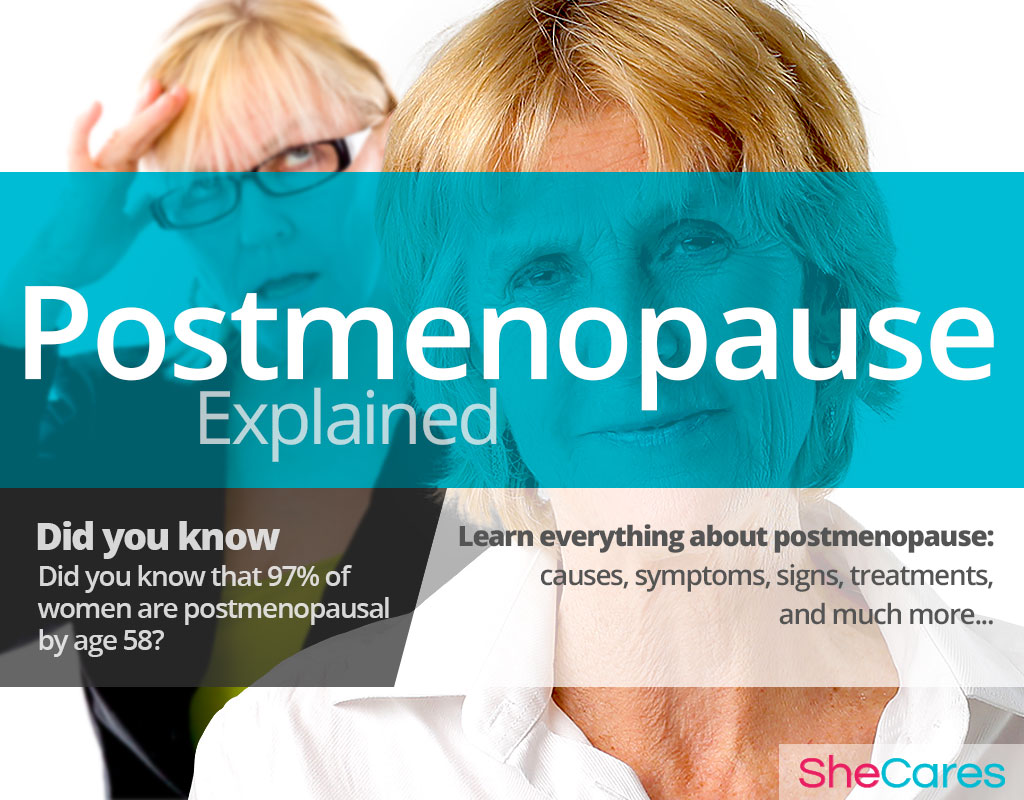About
Quick Facts about Postmenopause
- Around 7% of women in their sixties still have intense menopause symptoms.
- 97% of are postmenopausal by age 58.
- Around one-quarter of women in the U.S. die of heart disease, a condition more likely to develop in postmenopausal women.
Menopause occurs on the day a woman has gone 12 consecutive months without a menstrual period. From this point on, she is in postmenopause. The average age of the menopause transition in the U.S. is 51, so most women enter postmenopause in their early to mid-fifties. By their late fifties, the vast majority of women are postmenopausal.
Identifying Postmenopause
Since postmenopause begins after a woman has not had a period for over a year, keeping track of menstrual cycles is the most straightforward way of identifying this transition. For many women, the symptoms of perimenopause also begin to diminish or disappear completely.
Continue reading for information on the causes behind postmenopause symptoms.
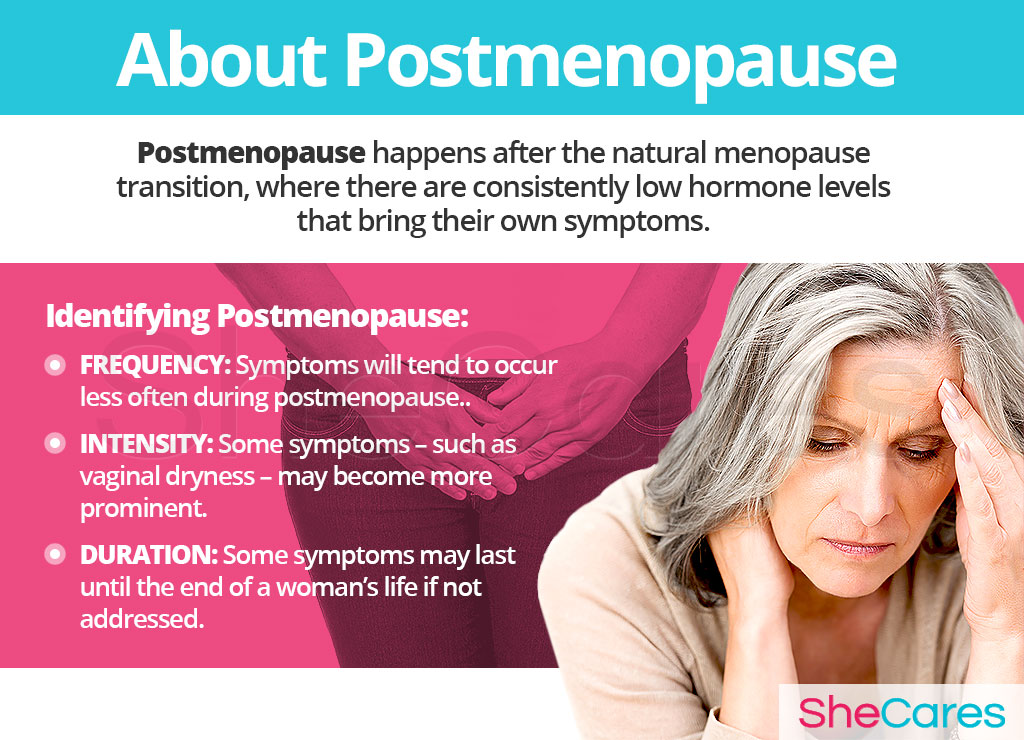
Causes
The main cause of postmenopause symptoms is low estrogen levels in the body. These consistently low levels also contribute to a heightened risk of developing certain conditions during this stage, although other factors also have a role.
Hormonal Causes of Postmenopause Symptoms
Estrogen, progesterone, and other sex hormones regulate the menstrual cycle. During the menstrual cycle, a follicle in the ovaries releases an egg. However, as women grow older, there are fewer and fewer follicles remaining. Hormone levels fluctuate up and down, and menstruation eventually stops permanently. When this occurs, estrogen levels tend to stay consistently low.
While estrogen is best-known for its role in regulating the menstrual cycle, it actually has many functions throughout the body. These include regulating bone growth, controlling the contraction of blood vessels, and influencing mood, to name a few. When estrogen levels are deficient during postmenopause, several symptoms may arise. Some postmenopause symptoms may also be linked to low progesterone levels.
Other Causes of Postmenopause Symptoms
While low estrogen levels are the main cause of most postmenopause symptoms, other factors can also contribute. For example, a poor diet, genetics, and lack of exercise may compound symptoms.
Continue to the next section for information on the specific symptoms of postmenopause, as well as conditions to look out for.
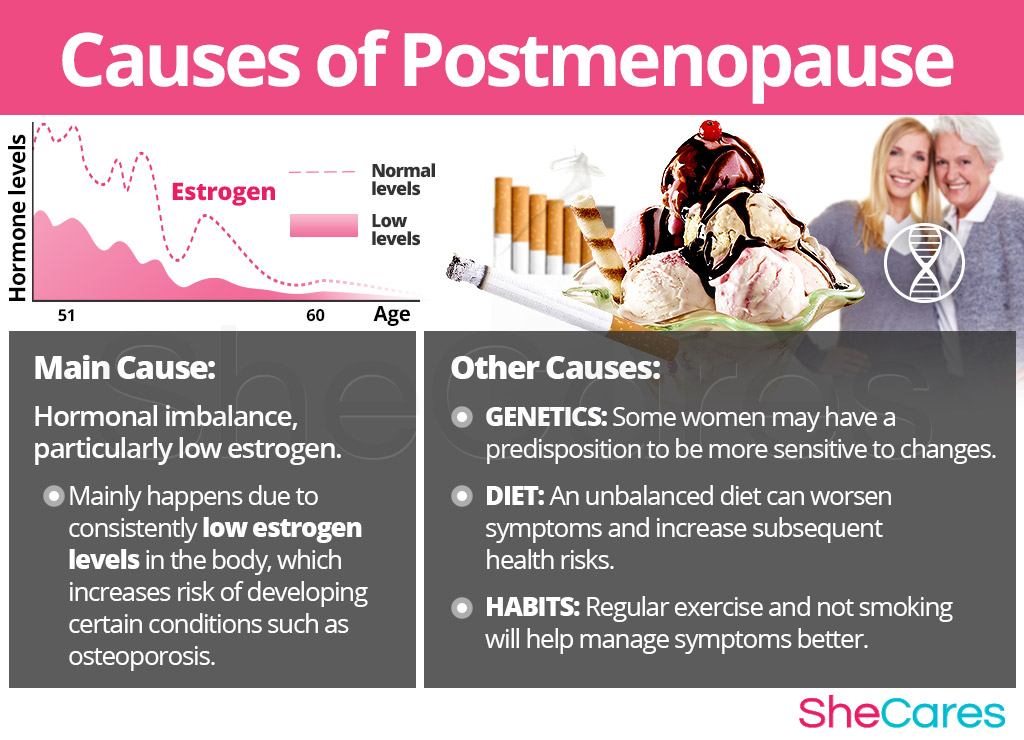
Signs and Symptoms
There may be some overlap between perimenopause and postmenopause symptoms, since perimenopause also includes phases of low estrogen levels. However, many women find that their perimenopause symptoms fade away after their period stops. New symptoms and changes may appear during this stage.
Symptoms of Postmenopause
The following are the most commonly-reported symptoms of postmenopause.
- Vaginal dryness
- Urinary incontinence
- Hair loss and thinning
- Loss of libido
- Insomnia or other sleep problems
- Memory lapses
- Difficulty concentrating
What other symptoms might be due to postmenopause? Some of the less common symptoms of perimenopause may appear or continue into postmenopause. Typically, they are linked to hormonal imbalance and possibly general aging.
Less common symptoms of postmenopause
- Hot flashes
- Night sweats
- Mood swings
- Irregular heartbeat
- Burning tongue or burning mouth
- Changes in body odor
- Brittle nails
- Dizziness
- Digestive problems, especially bloating
- Gum problems
- Tingling extremities (paresthesia)
- Increased or new allergies
- Muscle tension
- Itchy skin
- Electric shock sensation
Signs of Postmenopause
- High follicle stimulating hormone levels (over 70 IU/L)
- Low estrogen levels (less than 30 pg/mL)
- A bone density T-score of less than −1
- Lack of a period for 12 consecutive months
Diagnosis of Postmenopause
A woman is considered postmenopausal when she has gone 12 consecutive months without a period and there is no other medical condition present that would cause a lack of menstruation. To determine that the menopause transition has occurred, a doctor will typically perform three procedures: a review of the patient's medical history, a physical exam, and laboratory tests.
Complications of Postmenopause
While postmenopause symptoms typically do not have any complications per se, since menopause is a natural life transition. However, aging and low hormone levels can increase a woman's risk of developing certain conditions, such as osteoporosis and cardiovascular disease. Women are at particular risk as they enter postmenopause.
Warning Signs of Conditions Associated with Postmenopause
- Significant, ongoing weight gain
- High blood pressure
- Changes in vision
- Changes in stature
- Vaginal bleeding
- High cholesterol levels
It is important to keep a watchful eye for any warning signs and monitor them properly in order to distinguish when they could signal a more serious condition.
Postmenopause is a natural life stage, but the symptoms can interfere with daily life and require treatment. In addition, many women seek safe and natural means of preventing chronic conditions or lowering their risk of developing them during postmenopause.
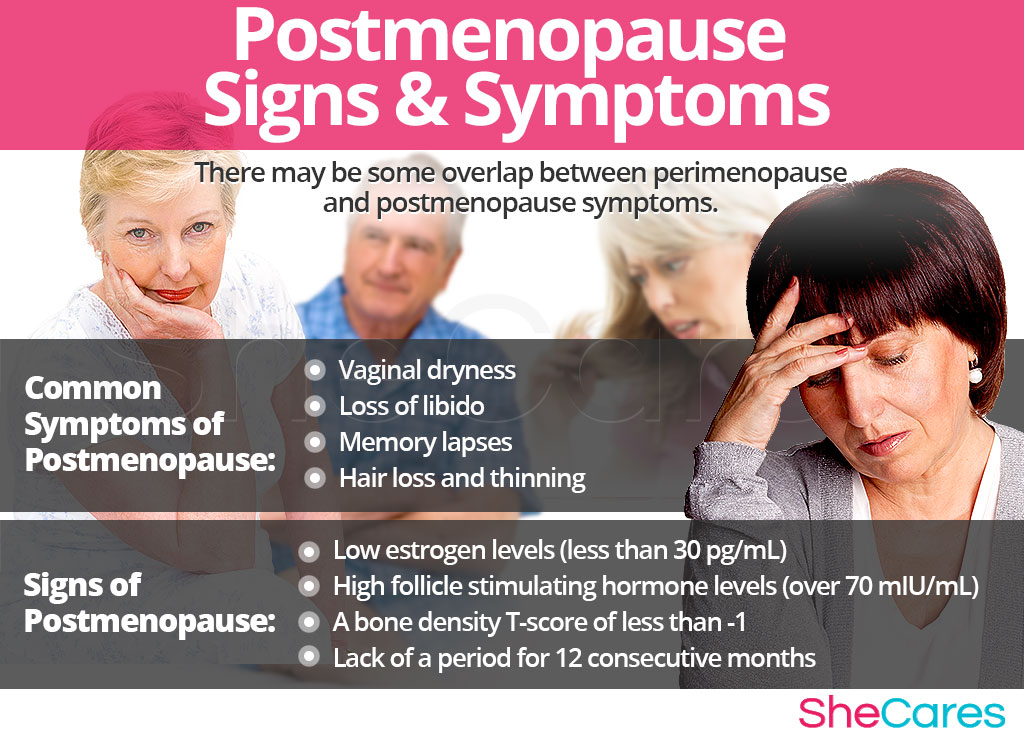
Treatments
Postmenopause symptoms are generally linked to hormonal imbalance, but since other factors can also influence them, it may be necessary to tackle the treatment of these symptoms from different angles. Balancing hormone levels can not only reduce postmenopause symptoms, but also help in the prevention of conditions associated with this stage.
Three Approaches to Treat Postmenopause Symptoms
Three levels of approaches can be considered for treating menopause symptoms. These are categorized as: (1) Lifestyle Changes, (2) Alternative Medicine, and (3) Pharmaceutical Options.
In general, lifestyle adjustments help to relieve symptoms while also benefiting overall health. They also involve the least risk of all the approaches, but conversely, the most dedication. If these changes prove insufficient in alleviating postmenopause symptoms, a hormone-balancing treatment may be necessary. Pharmaceutical options tend to be reserved for the most severe cases because of the cost and risk they entail.
Lifestyle Changes for Postmenopause Symptoms
Healthy lifestyle changes are considered the first recourse for preventing osteoporosis, cardiovascular disease, and other conditions associated with postmenopause. They can also help alleviate postmenopause symptoms. Generally, a healthy diet, exercise, and wholesome habits are recommended.
While lifestyle changes may be the key to prevention, they may not directly address hormonal imbalance. In such cases, some forms of alternative medicine can help with hormone levels.
Alternative Medicine for Postmenopause Symptoms
Of the many modalities proposed by alternative medicine, one in particular can help balance hormone levels: herbal supplements.
Phytoestrogenic herbal supplements
Some herbs - such as soy and red clover - contain high amounts of phytoestrogens. These compounds are similar to human estrogen, so they can help relieve postmenopause symptoms that stem from low estrogen levels. However, they do not address levels of other hormones that may be deficient, such as progesterone. In addition, because estrogen-like compounds are being added to the body, they may slightly increase a woman's risk of developing blood clots or breast cancer.Hormone-regulating herbal supplements
These herbal supplements, such as Macafem, do not contain any hormones. Rather, they work by nourishing the hormonal glands with essential nutrients and unique alkaloids to support their function. This helps them to produced balanced amounts of the hormones the body needs - not just estrogen, but also progesterone and other hormones. Because of this action, they are considered a safe and effective way to balance hormone levels.
Additionally, other supplements and alternative practices may assist in the treatment of certain symptoms.
A woman's symptoms, depending on their severity, can often be managed with a combination of healthy habits and herbal supplements. This is also an optimal way to prevent health conditions linked with postmenopause. However, intense symptoms or developing conditions may require medical intervention.
Pharmaceutical Options for Postmenopause Symptoms
This approach typically entails more risk than the above approaches, but in some cases, it may be necessary. For general postmenopause symptoms caused by low estrogen levels, hormone replacement therapy (HRT) may be prescribed, though other medications may be used for specific conditions.
The different aspects of these approaches can be customized to best fit each individual woman's symptoms, needs, and preferences. Many women find effective relief and even overall wellness by combining healthy lifestyle changes with hormone-regulating herbal supplements.
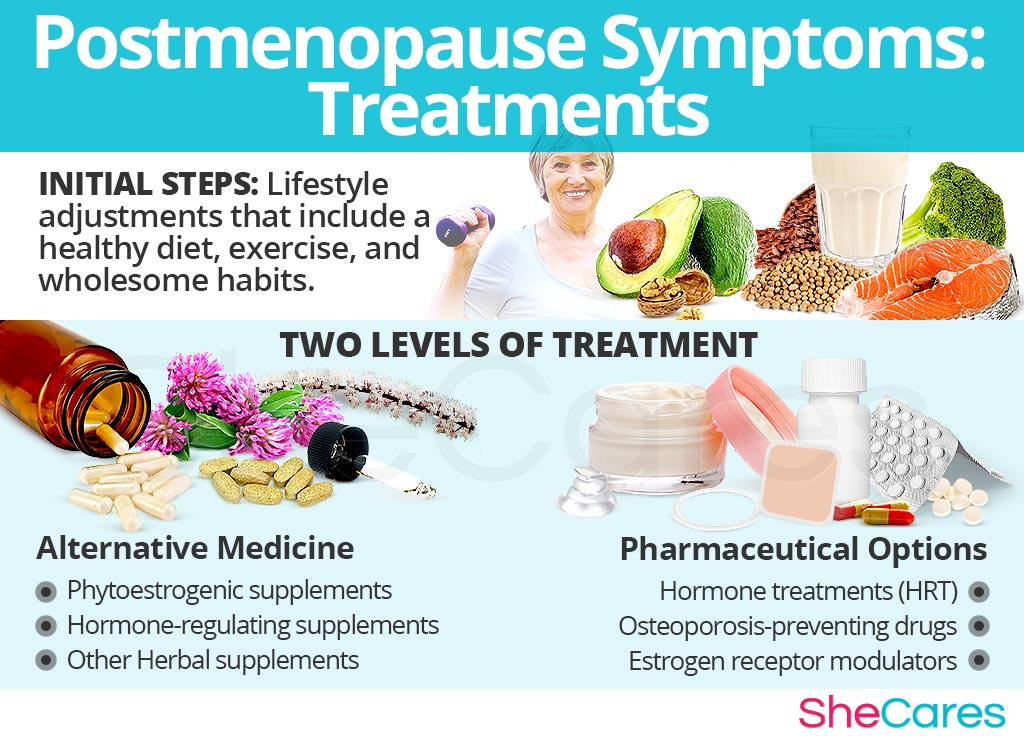
Sources
- Aidelsburger, P. et al. (2012). Alternative methods for the treatment of post-menopausal troubles. GMS Health Technology Assessment, 8, Doc03. doi: 10.3205/hta000101
- Bacciottini, L. et al. (2007). Phytoestrogens: food or drug? Clinical Cases in Mineral and Bone Metabolism, 4(2), 123-130. Retrieved from https://www.ncbi.nlm.nih.gov/pmc/articles/PMC2781234/
- Dalal, P.K. & Agarwal, M. (2015). Postmenopausal syndrome. Indian Journal of Psychiatry, 57(Suppl 2), S222-S232. doi: 10.4103/0019-5545.161483
- Franceschi, S. et al. (2000). Menopause and colorectal cancer. British Journal of Cancer, 82(11), 1860-1862. doi: 10.1054/bjoc.1999.1084
- Harvard Health Publications. (2015). Menopause symptoms can last longer than you expect. Retrieved April 3, 2017, from http://www.health.harvard.edu/womens-health/menopause-symptoms-can-last-longer-than-you-expect
- Harvard T.H. Chan School of Public Health. (2015). Butter is not back: Limiting saturated fat still best for heart health. Retrieved April 3, 2017, from https://www.hsph.harvard.edu/news/press-releases/butter-is-not-back-limiting-saturated-fat-still-best-for-heart-health/
- Kulzow, N. et al. (2016). Impact of Omega-3 Fatty Acid Supplementation on Memory Functions in Healthy Older Adults. Journal of Alzheimer's Disease, 51(3), 713-725. doi: 10.3233/JAD-150886.
- National Heart, Lung, and Blood Institute. (2012). Menopausal Hormone Therapy and Heart Disease. Retrieved April 3, 2017, from https://www.nhlbi.nih.gov/health/educational/hearttruth/lower-risk/hormone-therapy.htm
- National Institutes of Health. (2015). Estradiol blood test. Retrieved April 3, 2017, from https://medlineplus.gov/ency/article/003711.htm
- National Institutes of Health. (2014). Fiber. Retrieved April 3, 2017, from https://medlineplus.gov/ency/article/002470.htm
- National Institutes of Health. (2016). Heart Disease in Women. Retrieved April 3, 2017, from https://medlineplus.gov/heartdiseaseinwomen.html
- National Institutes of Health. (2015). Kegel exercises - self-care. Retrieved April 3, 2017, from https://medlineplus.gov/ency/patientinstructions/000141.htm
- National Institute on Aging. (2016). Menopause. Retrieved April 3, 2017, from https://www.nia.nih.gov/health/publication/menopause
- National Institute on Aging. (2016). Postmenopausal Health Concerns. Retrieved April 3, 2017, from https://www.nia.nih.gov/health/publication/menopause-time-change/postmenopausal-health-concerns
- National Institute of Arthritis and Musculoskeletal and Skin Diseases. (2015). Bone Mass Measurement: What the Numbers Mean. Retrieved April 3, 2017, from https://www.niams.nih.gov/health_info/bone/bone_health/bone_mass_measure.asp
- Office on Women's Health. (2010). Menopause basics. Retrieved April 3, 2017, from https://www.womenshealth.gov/menopause/menopause-basics/index.html
- Rad, P. et al. (2015). The effect of vitamin D on vaginal atrophy in postmenopausal women. Iranian Journal of Nursing and Midwifery Research, 20(2), 211-215. Retrieved from https://www.ncbi.nlm.nih.gov/pmc/articles/PMC4387645/
- Sliwinski, J.R. , Johnson, A.K. & Elkins, G.R. (2014). Memory Decline in Peri- and Post-menopausal Women: The Potential of Mind-Body Medicine to Improve Cognitive Performance. Integrative Medicine Insights, 9, 17-23. doi: 10.4137/IMI.S15682
- University of Maryland Medical Center. (2015). Menopause. Retrieved April 3, 2017, from http://umm.edu/health/medical/altmed/condition/menopause
- University of Pennsylvania, Perelman School of Medicine. (n.d.). Menopause. Retrieved April 3, 2017, from http://www.med.upenn.edu/womenswellness/menopause.html
- Vajaranant, T.S. & Pasquale, L.R. (2012). Estrogen deficiency accelerates aging of the optic nerve. Menopause, 19(8), 942-947. doi: 10.1097/gme.0b013e3182443137
